TAX 5: Addressing Accounting Issues for Beachlife Ltd. - Report
VerifiedAdded on 2020/05/28
|9
|1914
|55
Report
AI Summary
This report addresses accounting issues faced by Beachlife Ltd., as outlined in a letter to the Managing Director, Christopher Sampson. The report focuses on two key areas: a pending court case for patent infringement and a sale agreement with a maintenance clause. It meticulously analyzes these situations, referencing AASB 137 to determine the appropriate accounting treatments for provisions and contingent liabilities. The report recommends recognizing a contingent liability for the potential legal claim and providing an estimate of the financial effect, while also advising on the proper recognition of the sale, the creation of a provision for maintenance expenses, and the disclosure of a contingent liability related to the service quality. The recommendations are grounded in the specific requirements of AASB standards, ensuring a comprehensive and compliant approach to financial reporting.
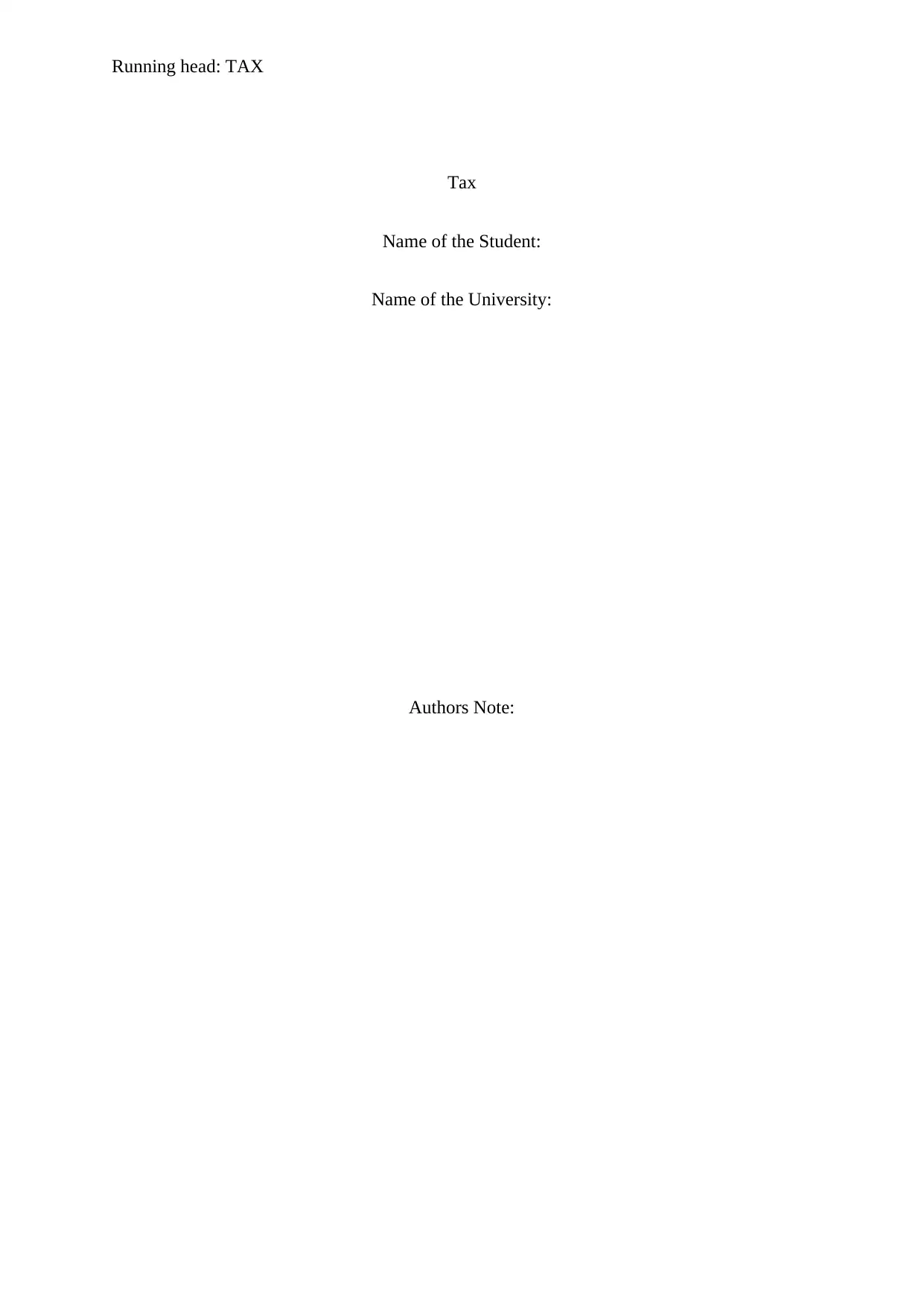
Running head: TAX
Tax
Name of the Student:
Name of the University:
Authors Note:
Tax
Name of the Student:
Name of the University:
Authors Note:
Paraphrase This Document
Need a fresh take? Get an instant paraphrase of this document with our AI Paraphraser
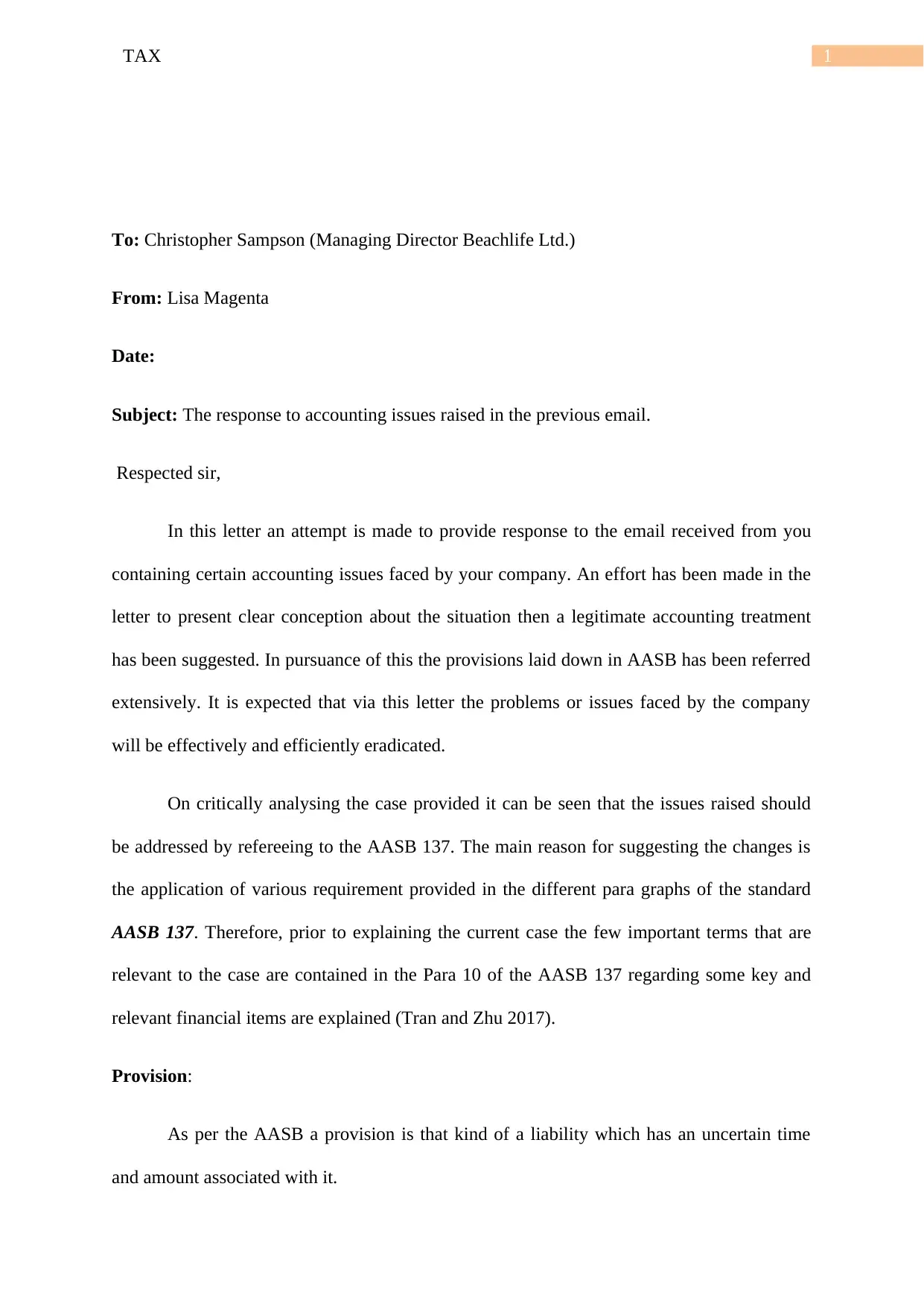
1TAX
To: Christopher Sampson (Managing Director Beachlife Ltd.)
From: Lisa Magenta
Date:
Subject: The response to accounting issues raised in the previous email.
Respected sir,
In this letter an attempt is made to provide response to the email received from you
containing certain accounting issues faced by your company. An effort has been made in the
letter to present clear conception about the situation then a legitimate accounting treatment
has been suggested. In pursuance of this the provisions laid down in AASB has been referred
extensively. It is expected that via this letter the problems or issues faced by the company
will be effectively and efficiently eradicated.
On critically analysing the case provided it can be seen that the issues raised should
be addressed by refereeing to the AASB 137. The main reason for suggesting the changes is
the application of various requirement provided in the different para graphs of the standard
AASB 137. Therefore, prior to explaining the current case the few important terms that are
relevant to the case are contained in the Para 10 of the AASB 137 regarding some key and
relevant financial items are explained (Tran and Zhu 2017).
Provision:
As per the AASB a provision is that kind of a liability which has an uncertain time
and amount associated with it.
To: Christopher Sampson (Managing Director Beachlife Ltd.)
From: Lisa Magenta
Date:
Subject: The response to accounting issues raised in the previous email.
Respected sir,
In this letter an attempt is made to provide response to the email received from you
containing certain accounting issues faced by your company. An effort has been made in the
letter to present clear conception about the situation then a legitimate accounting treatment
has been suggested. In pursuance of this the provisions laid down in AASB has been referred
extensively. It is expected that via this letter the problems or issues faced by the company
will be effectively and efficiently eradicated.
On critically analysing the case provided it can be seen that the issues raised should
be addressed by refereeing to the AASB 137. The main reason for suggesting the changes is
the application of various requirement provided in the different para graphs of the standard
AASB 137. Therefore, prior to explaining the current case the few important terms that are
relevant to the case are contained in the Para 10 of the AASB 137 regarding some key and
relevant financial items are explained (Tran and Zhu 2017).
Provision:
As per the AASB a provision is that kind of a liability which has an uncertain time
and amount associated with it.

2TAX
Contingent Liability:
It is defined as
A) An obligation which may possibly arise out of past events and its actuality will be
substantiated by the happening or non-happening of one or more future events that is
uncertain which are not wholly within the control of the management or company
(Crawford et al. 2014).
B) A current obligation that has arisen out of past events but is not recognised due to:
i) Less chances of an outflow of resources embodying economic benefits
being required for the settlement of the obligation
ii) The amount that is required to settle the obligation cannot be
established reliably based on the available information.
Relationship between provision and contingent liability:
It can be said that due to uncertainty in the amount and the timing of the occurrence in
general perception it is assumed that all the provisions are contingent because of the
uncertainty in the amount and timing of their occurrence. But, the standard in Para 12 and
Para 13 has made a clear distinction between the provisions and contingent liabilities.
Contingent liabilities will only be those liabilities whose existence depends on the occurrence
or non-occurrence of an uncertain event in future that is beyond the whole control of the
entity. Moreover, those liabilities will also be termed as contingent which does not fulfil the
recognition criteria (Tran 2015).
Recognition
The accounting treatment of the event is dependent on the recognition criteria stated
in the accounting standards.
Contingent Liability:
It is defined as
A) An obligation which may possibly arise out of past events and its actuality will be
substantiated by the happening or non-happening of one or more future events that is
uncertain which are not wholly within the control of the management or company
(Crawford et al. 2014).
B) A current obligation that has arisen out of past events but is not recognised due to:
i) Less chances of an outflow of resources embodying economic benefits
being required for the settlement of the obligation
ii) The amount that is required to settle the obligation cannot be
established reliably based on the available information.
Relationship between provision and contingent liability:
It can be said that due to uncertainty in the amount and the timing of the occurrence in
general perception it is assumed that all the provisions are contingent because of the
uncertainty in the amount and timing of their occurrence. But, the standard in Para 12 and
Para 13 has made a clear distinction between the provisions and contingent liabilities.
Contingent liabilities will only be those liabilities whose existence depends on the occurrence
or non-occurrence of an uncertain event in future that is beyond the whole control of the
entity. Moreover, those liabilities will also be termed as contingent which does not fulfil the
recognition criteria (Tran 2015).
Recognition
The accounting treatment of the event is dependent on the recognition criteria stated
in the accounting standards.
⊘ This is a preview!⊘
Do you want full access?
Subscribe today to unlock all pages.

Trusted by 1+ million students worldwide
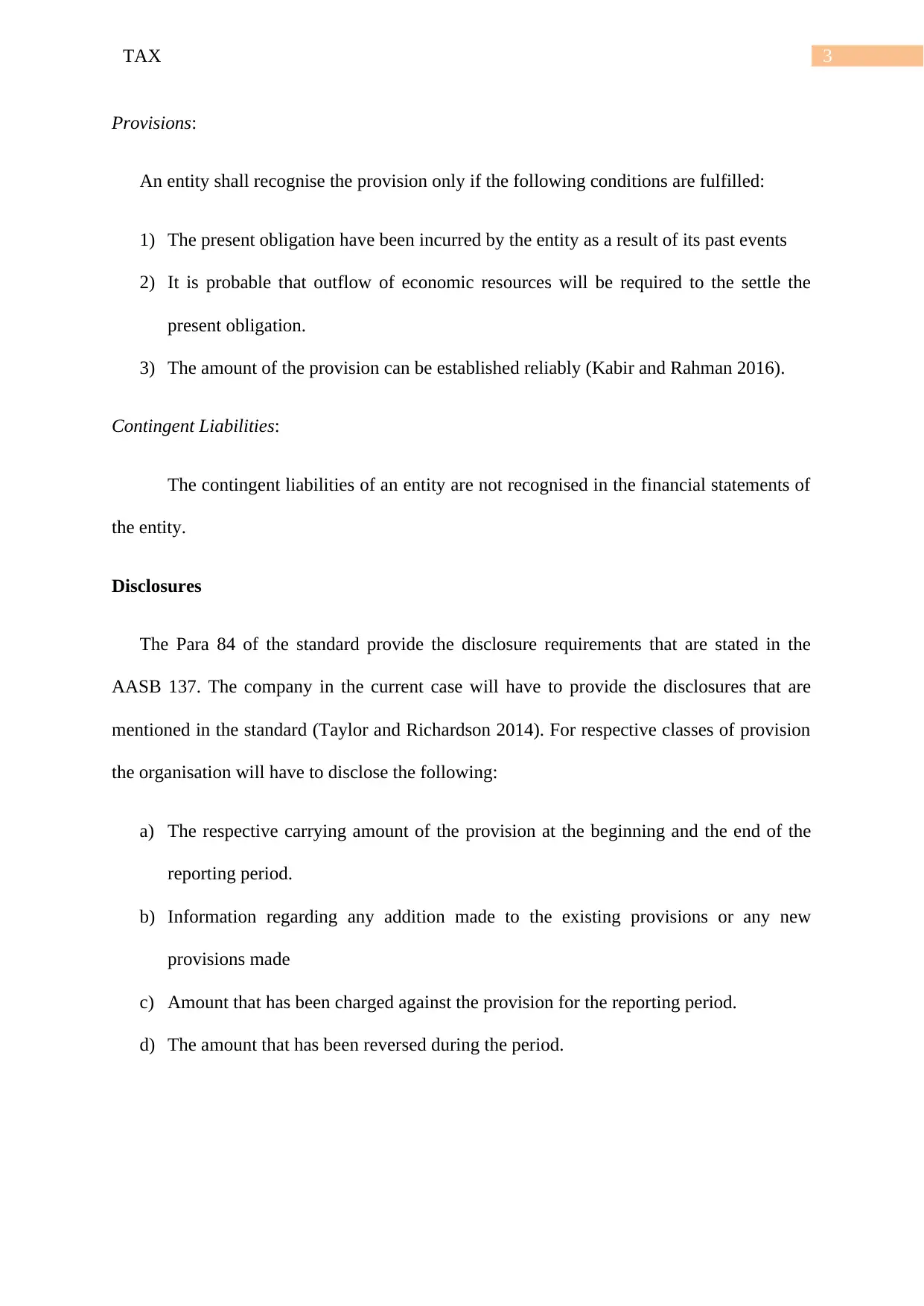
3TAX
Provisions:
An entity shall recognise the provision only if the following conditions are fulfilled:
1) The present obligation have been incurred by the entity as a result of its past events
2) It is probable that outflow of economic resources will be required to the settle the
present obligation.
3) The amount of the provision can be established reliably (Kabir and Rahman 2016).
Contingent Liabilities:
The contingent liabilities of an entity are not recognised in the financial statements of
the entity.
Disclosures
The Para 84 of the standard provide the disclosure requirements that are stated in the
AASB 137. The company in the current case will have to provide the disclosures that are
mentioned in the standard (Taylor and Richardson 2014). For respective classes of provision
the organisation will have to disclose the following:
a) The respective carrying amount of the provision at the beginning and the end of the
reporting period.
b) Information regarding any addition made to the existing provisions or any new
provisions made
c) Amount that has been charged against the provision for the reporting period.
d) The amount that has been reversed during the period.
Provisions:
An entity shall recognise the provision only if the following conditions are fulfilled:
1) The present obligation have been incurred by the entity as a result of its past events
2) It is probable that outflow of economic resources will be required to the settle the
present obligation.
3) The amount of the provision can be established reliably (Kabir and Rahman 2016).
Contingent Liabilities:
The contingent liabilities of an entity are not recognised in the financial statements of
the entity.
Disclosures
The Para 84 of the standard provide the disclosure requirements that are stated in the
AASB 137. The company in the current case will have to provide the disclosures that are
mentioned in the standard (Taylor and Richardson 2014). For respective classes of provision
the organisation will have to disclose the following:
a) The respective carrying amount of the provision at the beginning and the end of the
reporting period.
b) Information regarding any addition made to the existing provisions or any new
provisions made
c) Amount that has been charged against the provision for the reporting period.
d) The amount that has been reversed during the period.
Paraphrase This Document
Need a fresh take? Get an instant paraphrase of this document with our AI Paraphraser
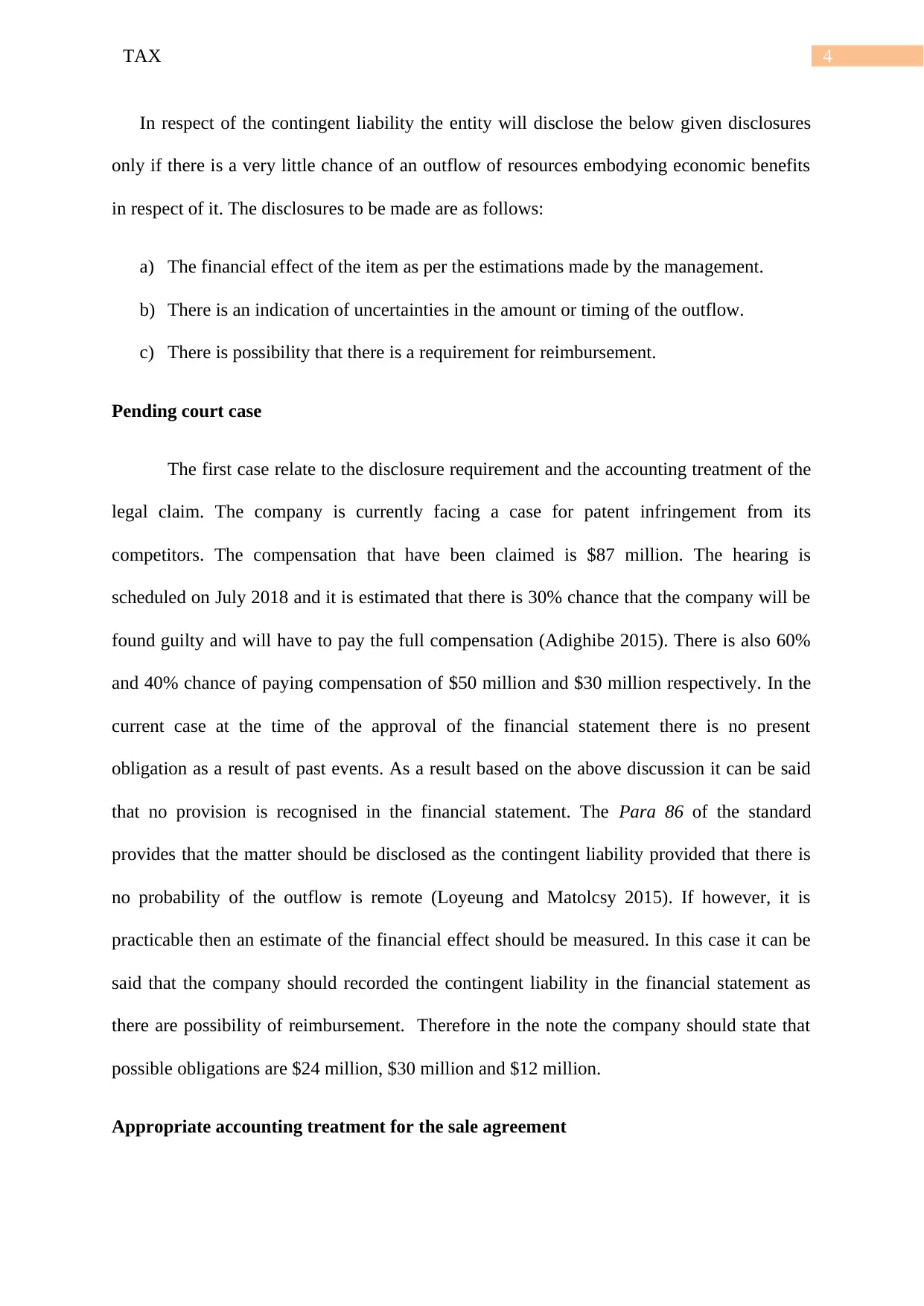
4TAX
In respect of the contingent liability the entity will disclose the below given disclosures
only if there is a very little chance of an outflow of resources embodying economic benefits
in respect of it. The disclosures to be made are as follows:
a) The financial effect of the item as per the estimations made by the management.
b) There is an indication of uncertainties in the amount or timing of the outflow.
c) There is possibility that there is a requirement for reimbursement.
Pending court case
The first case relate to the disclosure requirement and the accounting treatment of the
legal claim. The company is currently facing a case for patent infringement from its
competitors. The compensation that have been claimed is $87 million. The hearing is
scheduled on July 2018 and it is estimated that there is 30% chance that the company will be
found guilty and will have to pay the full compensation (Adighibe 2015). There is also 60%
and 40% chance of paying compensation of $50 million and $30 million respectively. In the
current case at the time of the approval of the financial statement there is no present
obligation as a result of past events. As a result based on the above discussion it can be said
that no provision is recognised in the financial statement. The Para 86 of the standard
provides that the matter should be disclosed as the contingent liability provided that there is
no probability of the outflow is remote (Loyeung and Matolcsy 2015). If however, it is
practicable then an estimate of the financial effect should be measured. In this case it can be
said that the company should recorded the contingent liability in the financial statement as
there are possibility of reimbursement. Therefore in the note the company should state that
possible obligations are $24 million, $30 million and $12 million.
Appropriate accounting treatment for the sale agreement
In respect of the contingent liability the entity will disclose the below given disclosures
only if there is a very little chance of an outflow of resources embodying economic benefits
in respect of it. The disclosures to be made are as follows:
a) The financial effect of the item as per the estimations made by the management.
b) There is an indication of uncertainties in the amount or timing of the outflow.
c) There is possibility that there is a requirement for reimbursement.
Pending court case
The first case relate to the disclosure requirement and the accounting treatment of the
legal claim. The company is currently facing a case for patent infringement from its
competitors. The compensation that have been claimed is $87 million. The hearing is
scheduled on July 2018 and it is estimated that there is 30% chance that the company will be
found guilty and will have to pay the full compensation (Adighibe 2015). There is also 60%
and 40% chance of paying compensation of $50 million and $30 million respectively. In the
current case at the time of the approval of the financial statement there is no present
obligation as a result of past events. As a result based on the above discussion it can be said
that no provision is recognised in the financial statement. The Para 86 of the standard
provides that the matter should be disclosed as the contingent liability provided that there is
no probability of the outflow is remote (Loyeung and Matolcsy 2015). If however, it is
practicable then an estimate of the financial effect should be measured. In this case it can be
said that the company should recorded the contingent liability in the financial statement as
there are possibility of reimbursement. Therefore in the note the company should state that
possible obligations are $24 million, $30 million and $12 million.
Appropriate accounting treatment for the sale agreement
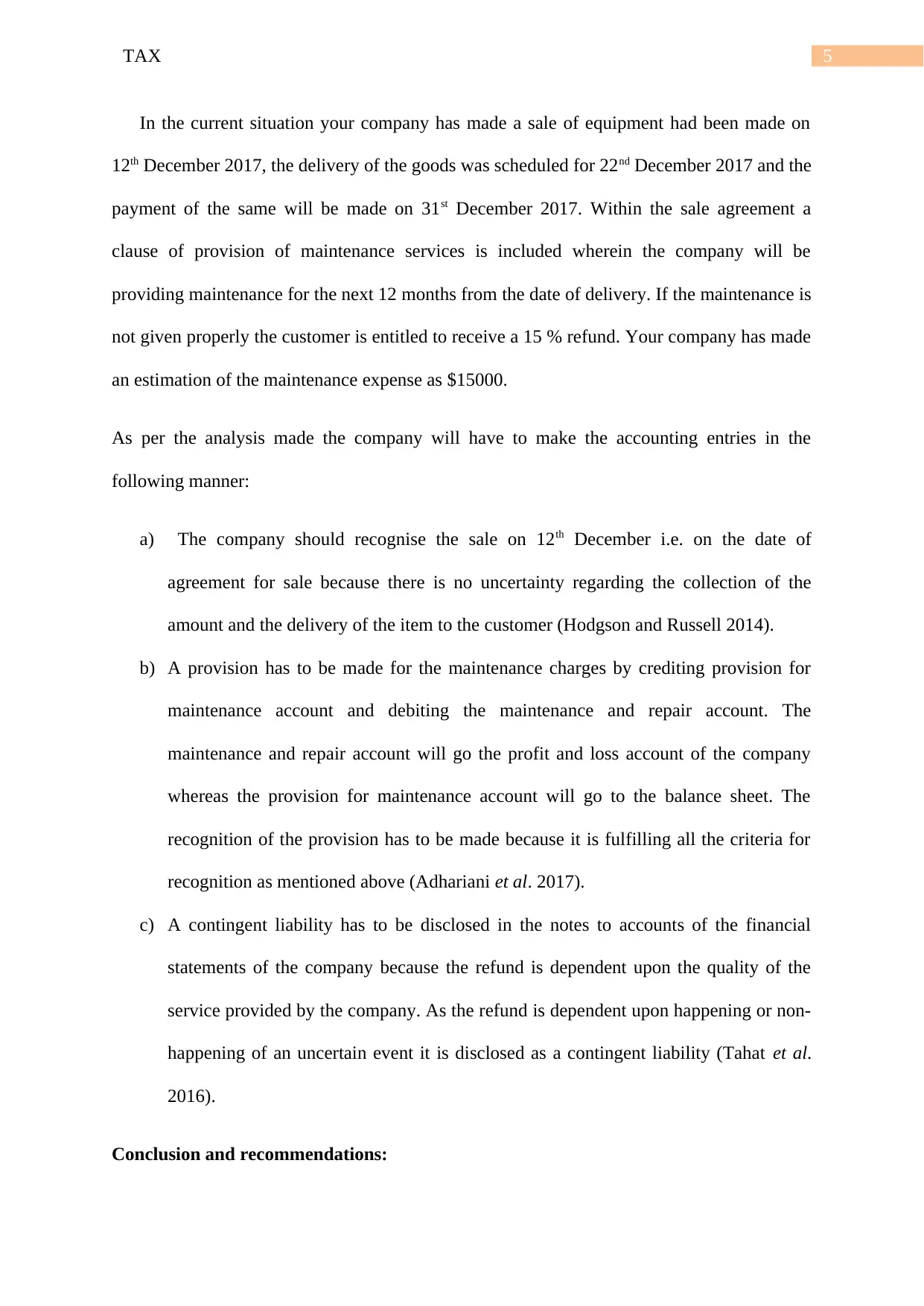
5TAX
In the current situation your company has made a sale of equipment had been made on
12th December 2017, the delivery of the goods was scheduled for 22nd December 2017 and the
payment of the same will be made on 31st December 2017. Within the sale agreement a
clause of provision of maintenance services is included wherein the company will be
providing maintenance for the next 12 months from the date of delivery. If the maintenance is
not given properly the customer is entitled to receive a 15 % refund. Your company has made
an estimation of the maintenance expense as $15000.
As per the analysis made the company will have to make the accounting entries in the
following manner:
a) The company should recognise the sale on 12th December i.e. on the date of
agreement for sale because there is no uncertainty regarding the collection of the
amount and the delivery of the item to the customer (Hodgson and Russell 2014).
b) A provision has to be made for the maintenance charges by crediting provision for
maintenance account and debiting the maintenance and repair account. The
maintenance and repair account will go the profit and loss account of the company
whereas the provision for maintenance account will go to the balance sheet. The
recognition of the provision has to be made because it is fulfilling all the criteria for
recognition as mentioned above (Adhariani et al. 2017).
c) A contingent liability has to be disclosed in the notes to accounts of the financial
statements of the company because the refund is dependent upon the quality of the
service provided by the company. As the refund is dependent upon happening or non-
happening of an uncertain event it is disclosed as a contingent liability (Tahat et al.
2016).
Conclusion and recommendations:
In the current situation your company has made a sale of equipment had been made on
12th December 2017, the delivery of the goods was scheduled for 22nd December 2017 and the
payment of the same will be made on 31st December 2017. Within the sale agreement a
clause of provision of maintenance services is included wherein the company will be
providing maintenance for the next 12 months from the date of delivery. If the maintenance is
not given properly the customer is entitled to receive a 15 % refund. Your company has made
an estimation of the maintenance expense as $15000.
As per the analysis made the company will have to make the accounting entries in the
following manner:
a) The company should recognise the sale on 12th December i.e. on the date of
agreement for sale because there is no uncertainty regarding the collection of the
amount and the delivery of the item to the customer (Hodgson and Russell 2014).
b) A provision has to be made for the maintenance charges by crediting provision for
maintenance account and debiting the maintenance and repair account. The
maintenance and repair account will go the profit and loss account of the company
whereas the provision for maintenance account will go to the balance sheet. The
recognition of the provision has to be made because it is fulfilling all the criteria for
recognition as mentioned above (Adhariani et al. 2017).
c) A contingent liability has to be disclosed in the notes to accounts of the financial
statements of the company because the refund is dependent upon the quality of the
service provided by the company. As the refund is dependent upon happening or non-
happening of an uncertain event it is disclosed as a contingent liability (Tahat et al.
2016).
Conclusion and recommendations:
⊘ This is a preview!⊘
Do you want full access?
Subscribe today to unlock all pages.

Trusted by 1+ million students worldwide
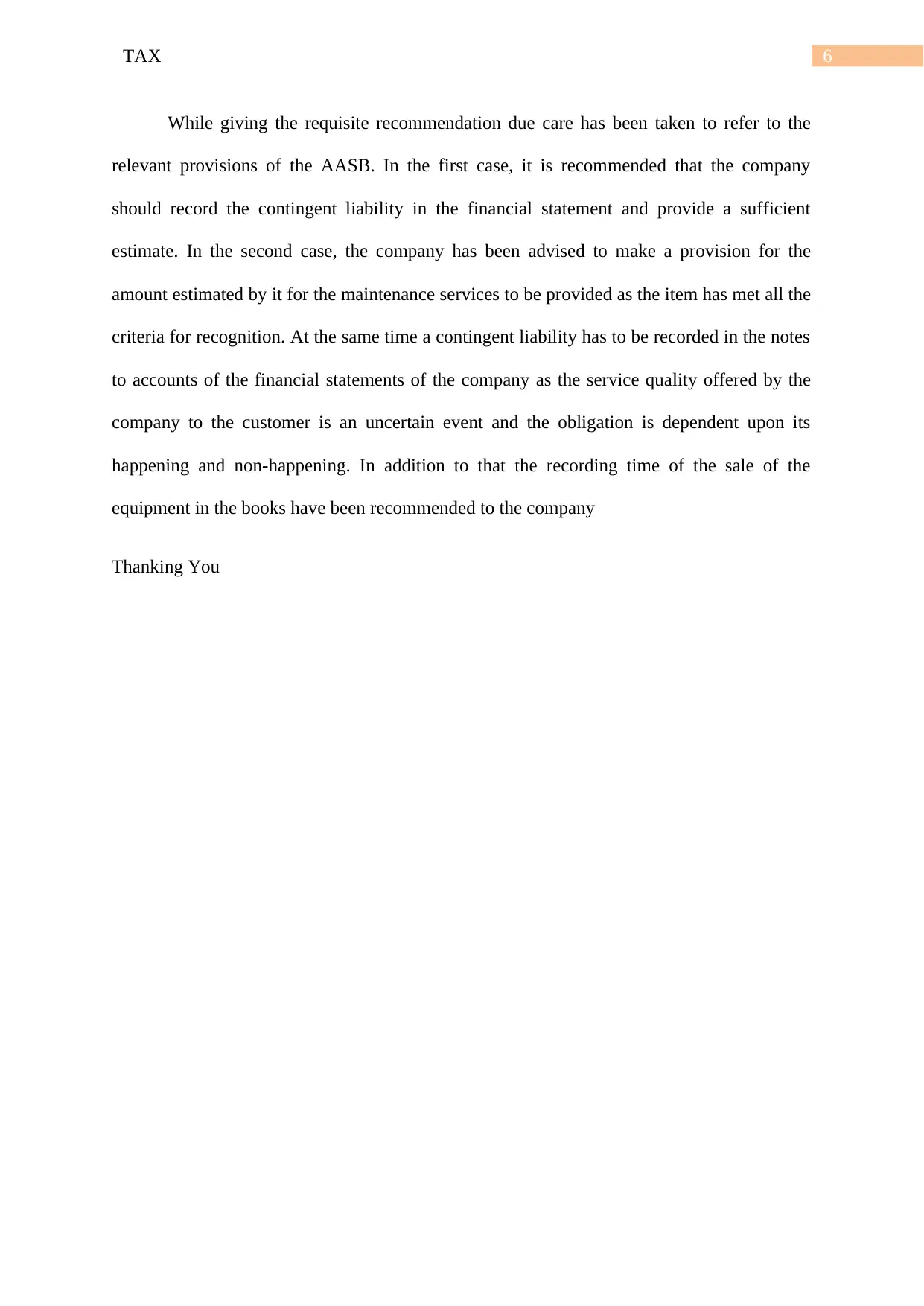
6TAX
While giving the requisite recommendation due care has been taken to refer to the
relevant provisions of the AASB. In the first case, it is recommended that the company
should record the contingent liability in the financial statement and provide a sufficient
estimate. In the second case, the company has been advised to make a provision for the
amount estimated by it for the maintenance services to be provided as the item has met all the
criteria for recognition. At the same time a contingent liability has to be recorded in the notes
to accounts of the financial statements of the company as the service quality offered by the
company to the customer is an uncertain event and the obligation is dependent upon its
happening and non-happening. In addition to that the recording time of the sale of the
equipment in the books have been recommended to the company
Thanking You
While giving the requisite recommendation due care has been taken to refer to the
relevant provisions of the AASB. In the first case, it is recommended that the company
should record the contingent liability in the financial statement and provide a sufficient
estimate. In the second case, the company has been advised to make a provision for the
amount estimated by it for the maintenance services to be provided as the item has met all the
criteria for recognition. At the same time a contingent liability has to be recorded in the notes
to accounts of the financial statements of the company as the service quality offered by the
company to the customer is an uncertain event and the obligation is dependent upon its
happening and non-happening. In addition to that the recording time of the sale of the
equipment in the books have been recommended to the company
Thanking You
Paraphrase This Document
Need a fresh take? Get an instant paraphrase of this document with our AI Paraphraser
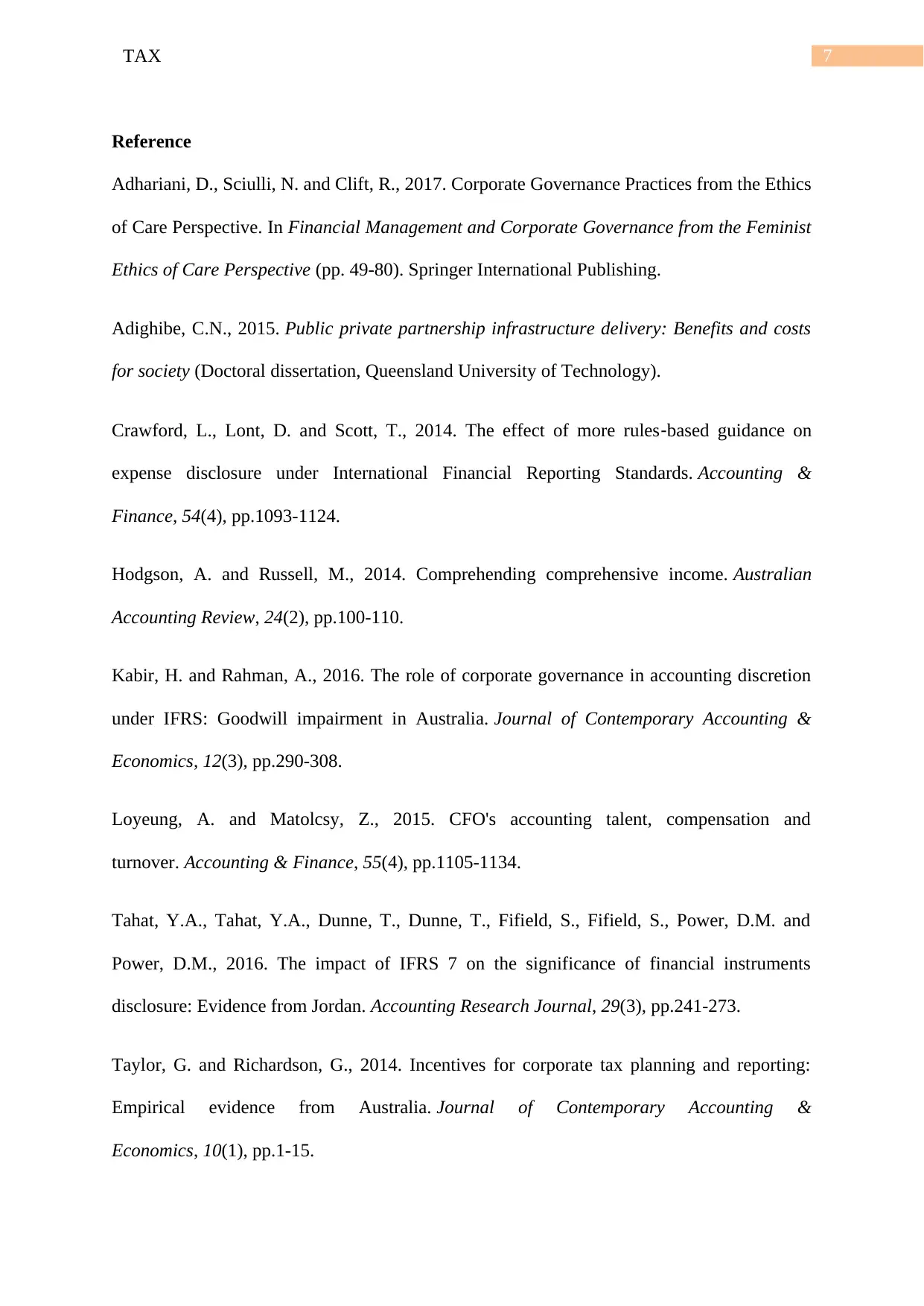
7TAX
Reference
Adhariani, D., Sciulli, N. and Clift, R., 2017. Corporate Governance Practices from the Ethics
of Care Perspective. In Financial Management and Corporate Governance from the Feminist
Ethics of Care Perspective (pp. 49-80). Springer International Publishing.
Adighibe, C.N., 2015. Public private partnership infrastructure delivery: Benefits and costs
for society (Doctoral dissertation, Queensland University of Technology).
Crawford, L., Lont, D. and Scott, T., 2014. The effect of more rules‐based guidance on
expense disclosure under International Financial Reporting Standards. Accounting &
Finance, 54(4), pp.1093-1124.
Hodgson, A. and Russell, M., 2014. Comprehending comprehensive income. Australian
Accounting Review, 24(2), pp.100-110.
Kabir, H. and Rahman, A., 2016. The role of corporate governance in accounting discretion
under IFRS: Goodwill impairment in Australia. Journal of Contemporary Accounting &
Economics, 12(3), pp.290-308.
Loyeung, A. and Matolcsy, Z., 2015. CFO's accounting talent, compensation and
turnover. Accounting & Finance, 55(4), pp.1105-1134.
Tahat, Y.A., Tahat, Y.A., Dunne, T., Dunne, T., Fifield, S., Fifield, S., Power, D.M. and
Power, D.M., 2016. The impact of IFRS 7 on the significance of financial instruments
disclosure: Evidence from Jordan. Accounting Research Journal, 29(3), pp.241-273.
Taylor, G. and Richardson, G., 2014. Incentives for corporate tax planning and reporting:
Empirical evidence from Australia. Journal of Contemporary Accounting &
Economics, 10(1), pp.1-15.
Reference
Adhariani, D., Sciulli, N. and Clift, R., 2017. Corporate Governance Practices from the Ethics
of Care Perspective. In Financial Management and Corporate Governance from the Feminist
Ethics of Care Perspective (pp. 49-80). Springer International Publishing.
Adighibe, C.N., 2015. Public private partnership infrastructure delivery: Benefits and costs
for society (Doctoral dissertation, Queensland University of Technology).
Crawford, L., Lont, D. and Scott, T., 2014. The effect of more rules‐based guidance on
expense disclosure under International Financial Reporting Standards. Accounting &
Finance, 54(4), pp.1093-1124.
Hodgson, A. and Russell, M., 2014. Comprehending comprehensive income. Australian
Accounting Review, 24(2), pp.100-110.
Kabir, H. and Rahman, A., 2016. The role of corporate governance in accounting discretion
under IFRS: Goodwill impairment in Australia. Journal of Contemporary Accounting &
Economics, 12(3), pp.290-308.
Loyeung, A. and Matolcsy, Z., 2015. CFO's accounting talent, compensation and
turnover. Accounting & Finance, 55(4), pp.1105-1134.
Tahat, Y.A., Tahat, Y.A., Dunne, T., Dunne, T., Fifield, S., Fifield, S., Power, D.M. and
Power, D.M., 2016. The impact of IFRS 7 on the significance of financial instruments
disclosure: Evidence from Jordan. Accounting Research Journal, 29(3), pp.241-273.
Taylor, G. and Richardson, G., 2014. Incentives for corporate tax planning and reporting:
Empirical evidence from Australia. Journal of Contemporary Accounting &
Economics, 10(1), pp.1-15.
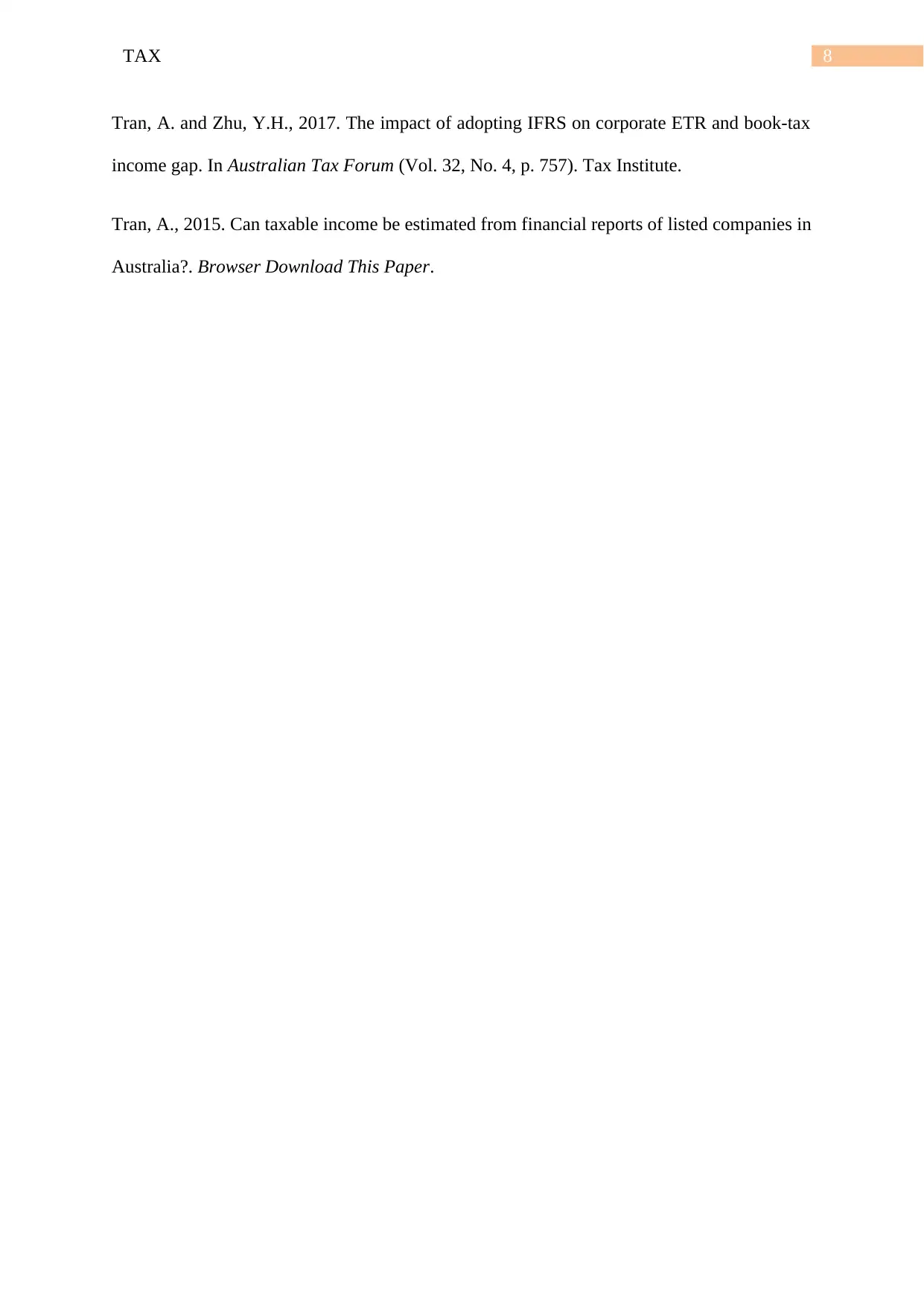
8TAX
Tran, A. and Zhu, Y.H., 2017. The impact of adopting IFRS on corporate ETR and book-tax
income gap. In Australian Tax Forum (Vol. 32, No. 4, p. 757). Tax Institute.
Tran, A., 2015. Can taxable income be estimated from financial reports of listed companies in
Australia?. Browser Download This Paper.
Tran, A. and Zhu, Y.H., 2017. The impact of adopting IFRS on corporate ETR and book-tax
income gap. In Australian Tax Forum (Vol. 32, No. 4, p. 757). Tax Institute.
Tran, A., 2015. Can taxable income be estimated from financial reports of listed companies in
Australia?. Browser Download This Paper.
⊘ This is a preview!⊘
Do you want full access?
Subscribe today to unlock all pages.

Trusted by 1+ million students worldwide
1 out of 9
Related Documents
Your All-in-One AI-Powered Toolkit for Academic Success.
+13062052269
info@desklib.com
Available 24*7 on WhatsApp / Email
![[object Object]](/_next/static/media/star-bottom.7253800d.svg)
Unlock your academic potential
Copyright © 2020–2025 A2Z Services. All Rights Reserved. Developed and managed by ZUCOL.





